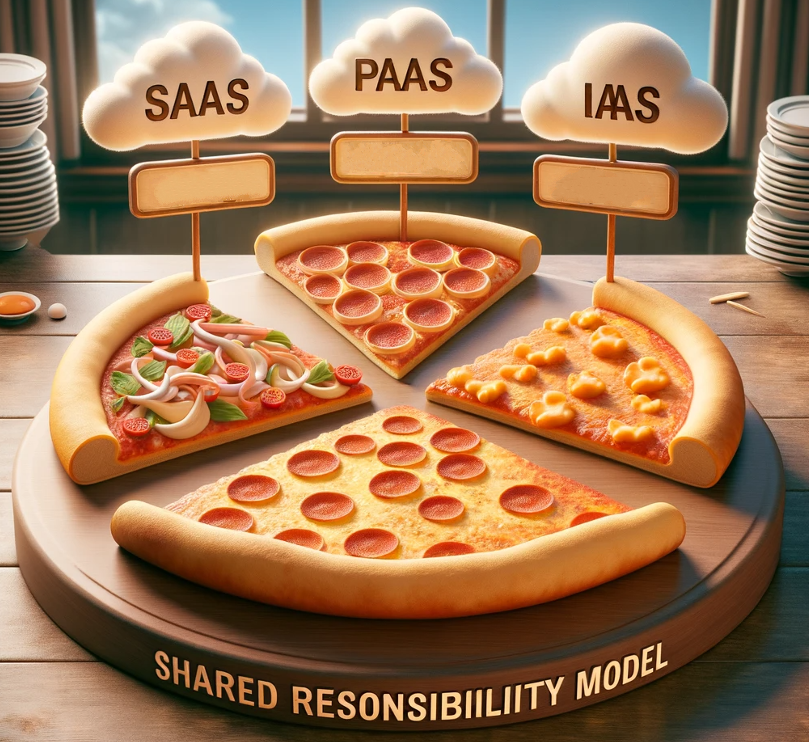This blog post focuses on the shared responsibility model with focus on cloud. There is nothing better than explaining a complex topic by using an analogy to something we all love, the pizza.
What is the Shared Responsibility Model?
The shared responsibility model is used by service providers, primarily in cloud, to define who is responsible for the services and resources. It's very important to understand it, as there is some misconception amongst customers on who has the responsibility for information, data, network, operating system and the physical elements when their workload is shifted towards cloud. The following diagram illustrates the areas of responsibility between Microsoft and customers when deploying resources on the cloud or onprem.
An analogy we all love
Let's imagine that we have built Pizza as a Service. You can get it delivered (fully managed service), pick up a pizza that is ready to bake at the closest supermarket (partially managed), or just go all in and make one from scratch at home (unmanaged service). This is similar to the choices you have with IT services:
Fully Managed : Here, the service provider handles everything. In the pizza world, this is like ordering a pizza via phone and getting it delivered, hot and ready to eat. In IT Services, this is the same as fully managed services where the provider takes care of the infrastructure, security, and maintenance. This is similar to the SaaS service in the diagram above.
Partially Managed : This is us going to the closest supermarket and buying a ready to bake pizza. We are responsible for baking it at home, but the pizza is ready, we don't need to make the dough, the topping etc. In IT Service terms, this means the service provider manages the infrastructure, but you're responsible for some aspects of the configuration and security. This would Infrastructure as a Service and Platform as a Service.
Unmanaged: This is us making a pizza from scratch at home. We need all the ingredients, oven, and the skills. Similarly, in an unmanaged IT service, you're responsible for all aspects. This would be us bying a server for our private datacenter, installing OS, preparing networking, installing applications and so on. We have full responsibility to maintain and update it, and we need the skills in-house.
How does all this tie to CISSP?
As you might already know, CISSP is built on different domains. Even though the shared responsibility model is not directly tied to the specific domains, it can easily be translated to some elements that can be tied to them.
Security and Risk Management domain focuses on understanding and managing risks. In our analogy from before, we need to know what risks we have on each level of service, whether it's fully managed, partially managed or unmanaged. It's very important to evaluate the security measures that are taken by the provider and the ones that we as a customer need to implement.
Asset Security domain on the other end focuses primarily on protecting the assets, which could be translated to data, applications and infrastructure. We need to ensure security measures have been taken on each asset either by us, or the provider.
Security Architecture and Engineering is mostly focused on design and implementation of security architectures. We need to understand each model, from SaaS, IaaS, PaaS, on-prem so that we can evaluate the impact each one of them has on the security responsibilities. This will help us design secure architectures wherever our workload resides.
Communication and Network Security is also very critical in Cloud Services. It's critical to make sure that we have secure networking and transmissions in the cloud and from cloud to on-prem. We need to make sure that the pizza we get delivered (data transmission) doesn't get messed up on the way to our door. We need to understand how much of the network security is the provider's responsibility and how much is ours.
We could go on and provide further considerations from the rest of the chapters, but as long as you understand the model it should be possible to make informed decisions, ensuring that both you as a customer and your provider play the part in maintaining and securing the environment.
Conclusion
In conclusion, the Shared Responsibility Model in cloud computing, much like our pizza analogy, reveals the importance of understanding the various layers of responsibility, whether you're choosing a cloud service or deciding what kind of pizza you are eating for dinner. Just as you would decide between ordering a fully prepared pizza or baking one from scratch, in the cloud environment, you need to make sure your choices take into consideration the security aspects that you will manage and the ones that your provider will.
References
Shared Responsibility Model - Amazon Web Services (AWS)
Shared responsibility in the cloud - Microsoft Azure | Microsoft Learn
(ISC)2 CISSP Certified Information Systems Security Professional Official Study Guide





.jpg)




